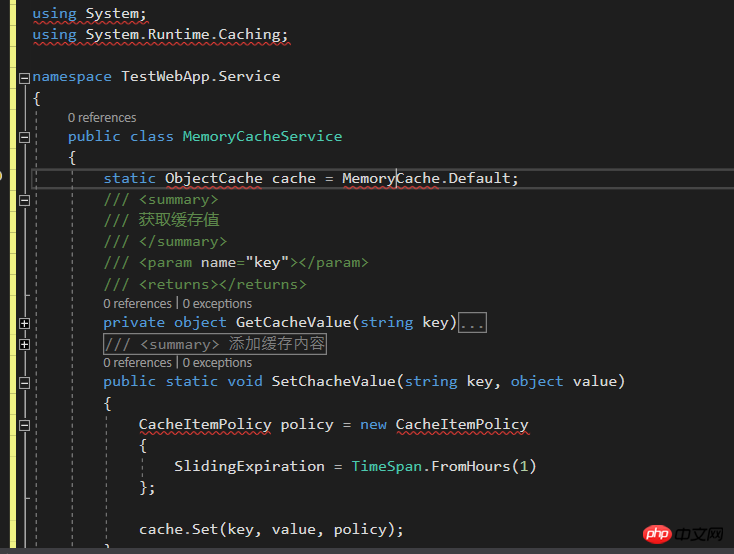.NET Core2.0小技巧之MemoryCache問題修復解決的方法(圖)
- 黄舟原創
- 2017-09-05 15:19:012494瀏覽
這篇文章主要為大家介紹了關於.NET Core 2.0遷移小技巧之MemoryCache問題修復解決的相關資料,文中透過範例程式碼介紹的非常詳細,對大家的學習或工作具有一定的參考學習價值,需要的朋友們下面隨著小編來一起學習學習吧。
前言
大家應該都知道,對於傳統的.NET Framework專案而言,System.Runtime.Caching命名空間是常用的工具了,其中MemoryCache類別則常被用來實作記憶體快取。
.NET Core 2.0暫時還不支援System.Runtime.Caching dll,這也表示MemoryCache相關程式碼不再運作了。
但好消息是,我們可以使用.NET Core 2.0的新API實作記憶體快取功能,簡單修改程式碼,解決不相容問題。下面話不多說了,來一起看看詳細的介紹吧。
解決方案
1.將舊程式碼匯入專案中,如下:
using System;
using System.Runtime.Caching;
namespace TestWebApp.Service
{
public class MemoryCacheService
{
static ObjectCache cache = MemoryCache.Default;
/// <summary>
/// 获取缓存值
/// </summary>
/// <param name="key"></param>
/// <returns></returns>
private object GetCacheValue(string key)
{
if (key != null && cache.Contains(key))
{
return cache[key];
}
return default(object);
}
/// <summary>
/// 添加缓存内容
/// </summary>
/// <param name="key"></param>
/// <param name="value"></param>
public static void SetChacheValue(string key, object value)
{
if (key != null)
{
CacheItemPolicy policy = new CacheItemPolicy
{
SlidingExpiration = TimeSpan.FromHours(1)
};
cache.Set(key, value, policy);
}
}
}
}導入後你會發現VS會提示無法找到System.Runtime.Caching命名空間,原有的程式碼無法直接編譯使用。

2.加入對Microsoft.Extensions.Caching.Memory命名空間的引用,它提供了.NET Core預設實作的MemoryCache類,以及全新的記憶體快取API
using Microsoft.Extensions.Caching.Memory;
3.改寫程式碼,使用新的API實作記憶體快取功能
初始化快取物件方式改寫前:
static ObjectCache cache = MemoryCache.Default;
初始化快取物件方式改寫後:
static MemoryCache cache = new MemoryCache(new MemoryCacheOptions());
讀取記憶體快取值方式變更:
private object GetCacheValue(string key)
{
if (key != null && cache.Contains(key))
{
return cache[key];
}
return default(object);
}改寫後:
private object GetCacheValue(string key)
{
object val = null;
if (key != null && cache.TryGetValue(key, out val))
{
return val;
}
else
{
return default(object);
}
}設定記憶體快取內容方式變更:
public static void SetChacheValue(string key, object value)
{
if (key != null)
{
CacheItemPolicy policy = new CacheItemPolicy
{
SlidingExpiration = TimeSpan.FromHours(1)
};
cache.Set(key, value, policy);
}
} 修改後:
public static void SetChacheValue(string key, object value)
{
if (key != null)
{
cache.Set(key, value, new MemoryCacheEntryOptions
{
SlidingExpiration = TimeSpan.FromHours(1)
});
}
}結論
Microsoft.Extensions.Caching.Memory下的新API改寫了舊程式碼後,你會發現原有的各種記憶體快取逾時策略全都是有對應新API的,包括AbsoluteExpiration, SlidingExpiration等等。
遷移後的完整程式碼如下:
#
using Microsoft.Extensions.Caching.Memory;
using System;
namespace TestMemoryCacheWebApp.Services
{
public class MemoryCacheService
{
static MemoryCache cache = new MemoryCache(new MemoryCacheOptions());
/// <summary>
/// 获取缓存值
/// </summary>
/// <param name="key"></param>
/// <returns></returns>
private object GetCacheValue(string key)
{
object val = null;
if (key != null && cache.TryGetValue(key, out val))
{
return val;
}
else
{
return default(object);
}
}
/// <summary>
/// 添加缓存内容
/// </summary>
/// <param name="key"></param>
/// <param name="value"></param>
public static void SetChacheValue(string key, object value)
{
if (key != null)
{
cache.Set(key, value, new MemoryCacheEntryOptions
{
SlidingExpiration = TimeSpan.FromHours(1)
});
}
}
}
}
總結
以上是.NET Core2.0小技巧之MemoryCache問題修復解決的方法(圖)的詳細內容。更多資訊請關注PHP中文網其他相關文章!

